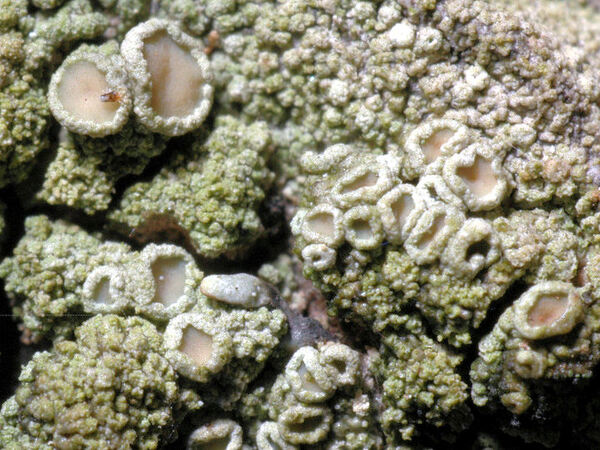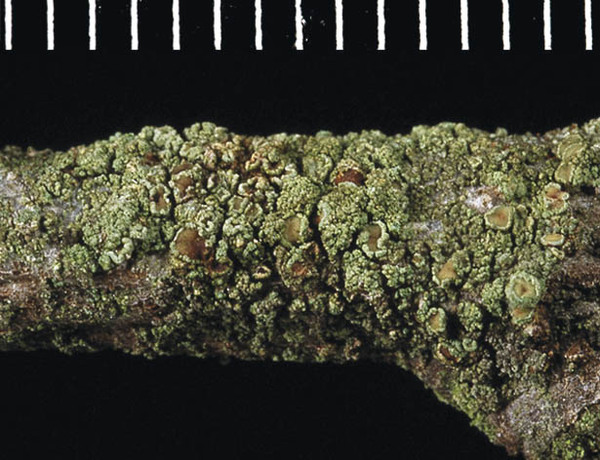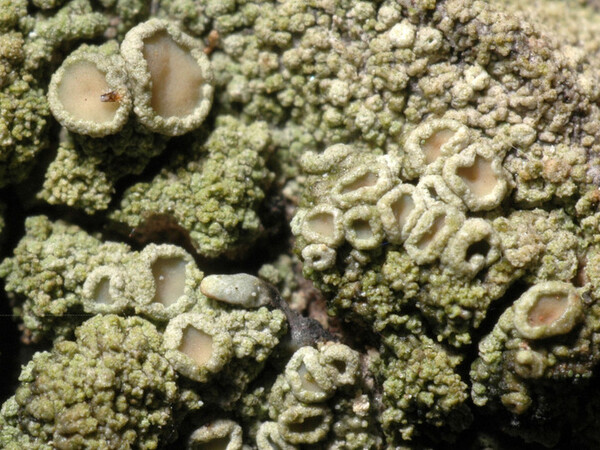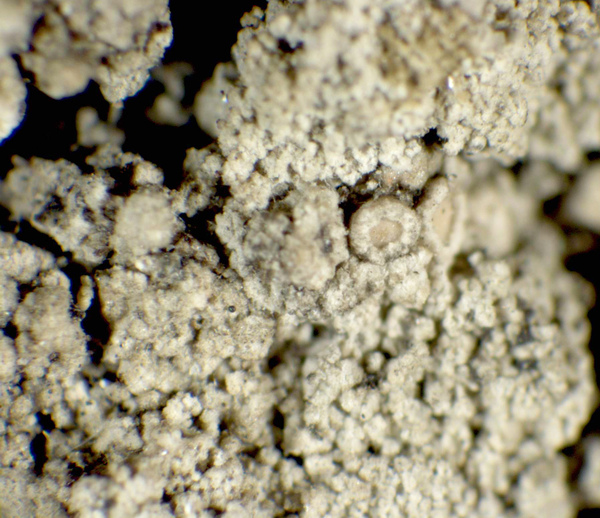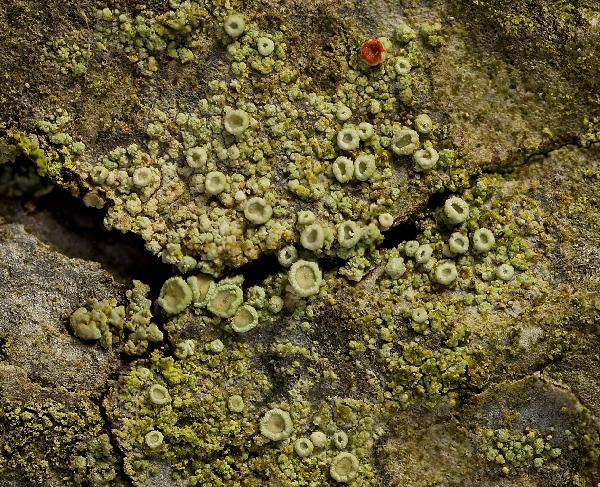Straminella conizaeoides (Nyl. ex Cromb.) S. Y. Kondr., Lőkös & Farkas
in Kondratyuk & al., Acta Bot. Hung., 61, 1-2: 158, 2019. Basionym: Lecanora conizaeoides Nyl. ex Cromb. - J. Bot., 23: 195, 1885.
Synonyms: Lecanora pityrea Erichsen
Distribution: N - Lomb (Zocchi & al. 1997), Piem (Griselli & al. 2003, Piervittori 2003, Piervittori & al. 1996b), VA (Valcuvia & al. 2000), Emil (Fariselli & al. 2020), Lig (Putortì & al. 1999b). C - Tosc (Tretiach & Ganis 1999, Putortì & al. 1999c, Brunialti & Frati 2010), Umb (Brackel 2015), Laz (Ravera 2006, 2006c). S - Cal (Puntillo 1996), Si (Brackel 2008b, 2008c).
Description: Thallus crustose, episubstratic, more or less continuous to cracked, thin to thick, greenish to grey-green, entirely or partially sorediate, the soredia coarsely granular. Apothecia lecanorine, 0.4-1(-1.5) mm across, sessile, slightly constricted at base, with a pale green-grey, grey-brown or pinkish brown, concave to slightly convex disc, and a thin, persistent, crenulate, partially sorediate thalline margin. Thalline exciple corticate (ecorticate in sorediate parts), 60-100 μm wide laterally; epithecium colourless to pale yellow-brown, with granules dissolving in K; hymenium colourless, 45-75(-90) μm high; paraphyses branched and anastomosing, 1.5-2.5 μm thick at mid-level, the apical cells to 3 μm wide; hypothecium colourless, 45-55 μm high. Asci 8-spored, clavate, very thin-walled, with a K/I+ blue, tall tholus penetrated by a faintly amyloid apical cushion, the wall K/I-, surrounded by a blue outer layer, Lecanora-type. Ascospores 1-celled, hyaline, broadly ellipsoid to ovoid, (7-)9-14(-16) x 4-7(-8) μm, thick-walled. Conidia thread-like, often curved, 12-22 μm long. Photobiont chlorococcoid. Spot tests: K- or K+ faintly yellow turning dirty red, C-, KC-, P+ yellow turning rust-red, UV+ dull orange. Chemistry: variable amounts of usnic and fumarprotocetraric acids.Note: this famous lichen, one of the most resistant against pollution, is very common in western Europe. Most of the Italian records, however, are dubious. An earlier record from Venezia Giulia (see Nimis 1993: 348), as well as that from Friuli by Badin & Nimis (1996) are wrong (vidi!), those from Sicily by Grillo & al. (1996) and Grillo (1998) should be checked, and are not accepted here. In recent times this species is known with certainly only from geothermic areas of Tuscany and Latium with emissions of sulphur dioxyde, where it is fairly abundant, and from Sicily. It is included in the Italian red list of epiphytic lichens as “Data Deficient” (Nascimbene & al. 2013c).
Growth form: Crustose
Substrata: bark
Photobiont: green algae other than Trentepohlia
Reproductive strategy: mainly sexual
Most common in areas with a humid-warm climate (e.g. most of Tyrrenian Italy)
Commonnes-rarity: (info)
Alpine belt: absent
Subalpine belt: absent
Oromediterranean belt: absent
Montane belt: absent
Submediterranean belt: very rare
Padanian area: very rare
Humid submediterranean belt: very rare
Humid mediterranean belt: absent
Dry mediterranean belt: absent
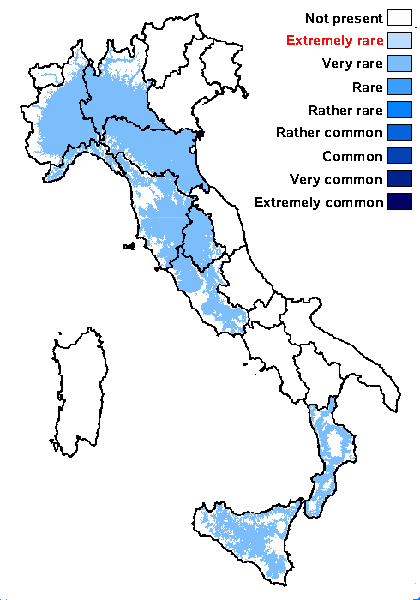
Predictive model
Herbarium samples
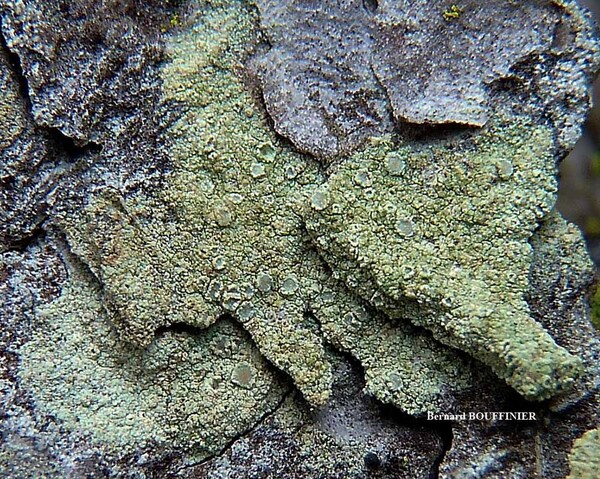
Bernard Bouffinier - Source: http://www.lichensmaritimes.org/index.php?task=fiche&lichen=539&lang=en
France, Crozon
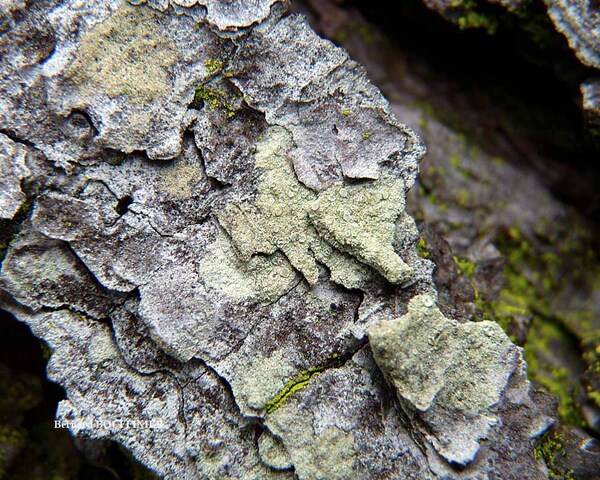
Bernard Bouffinier - Source: http://www.lichensmaritimes.org/index.php?task=fiche&lichen=539&lang=en
France, Crozon
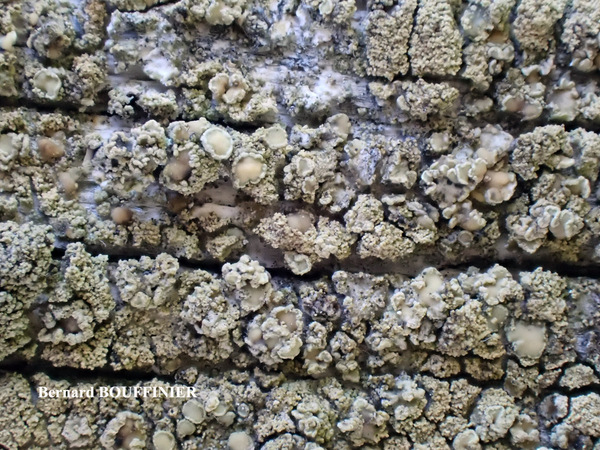
Bernard Bouffinier - Source: http://www.lichensmaritimes.org/index.php?task=fiche&lichen=539&lang=en
France, Menez-Meur
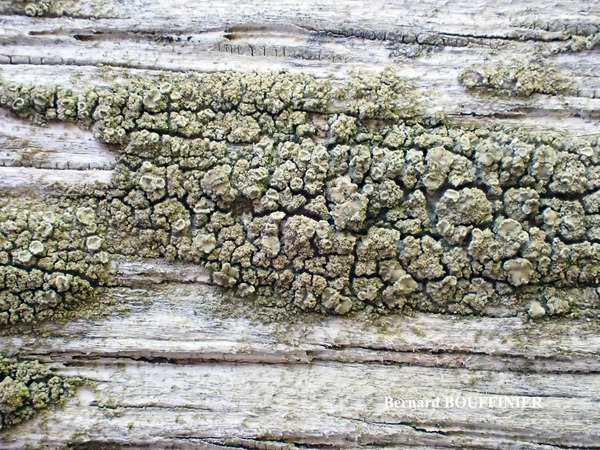
Bernard Bouffinier - Source: http://www.lichensmaritimes.org/index.php?task=fiche&lichen=539&lang=en
France, Menez-Meur
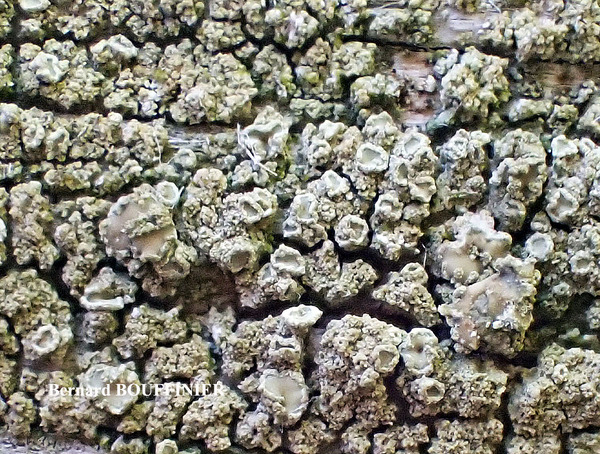
Bernard Bouffinier - Source: http://www.lichensmaritimes.org/index.php?task=fiche&lichen=539&lang=en
France, Menez-Meur
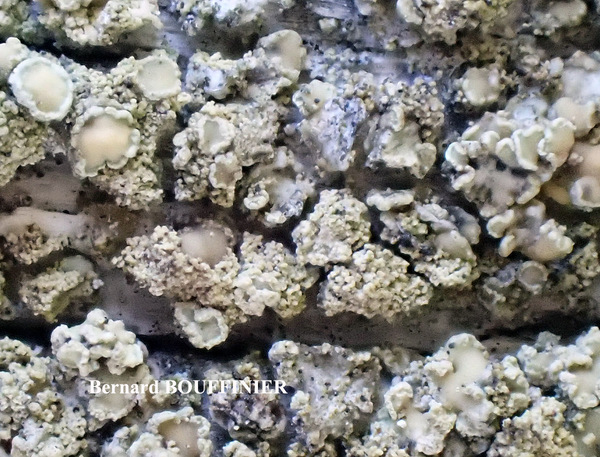
Bernard Bouffinier - Source: http://www.lichensmaritimes.org/index.php?task=fiche&lichen=539&lang=en
France, Menez-Meur

Bernard Bouffinier - Source: http://www.lichensmaritimes.org/index.php?task=fiche&lichen=539&lang=en
France, Menez-Meur
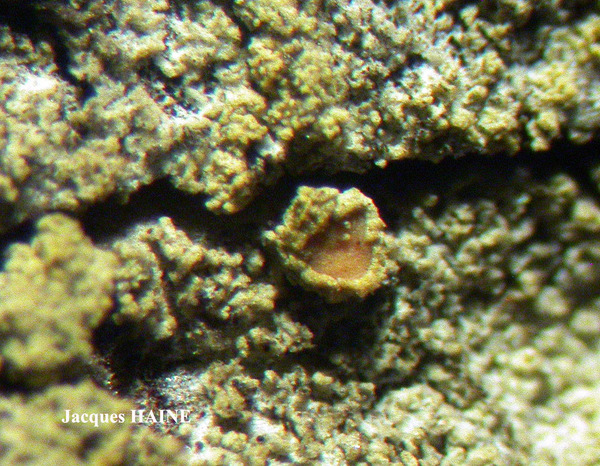
Jacques Haine - Source: http://www.lichensmaritimes.org/index.php?task=fiche&lichen=539&lang=en
Belgium, Han-sur-Lesse
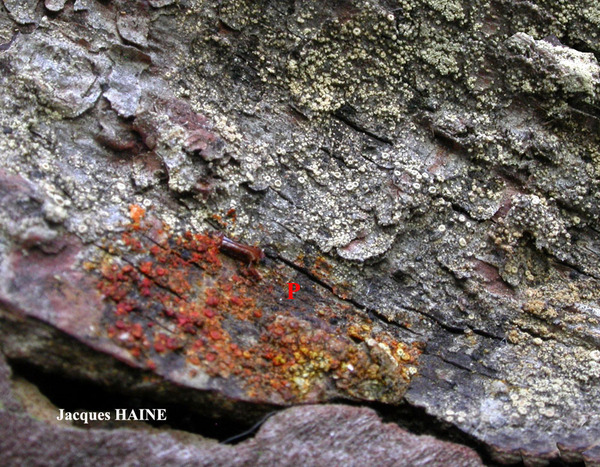
Jacques Haine - Source: http://www.lichensmaritimes.org/index.php?task=fiche&lichen=539&lang=en
Belgium, Han-sur-Lesse
Thallus P+ red
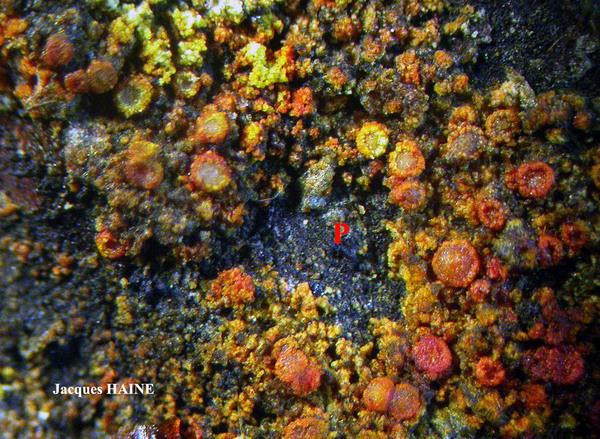
Jacques Haine - Source: http://www.lichensmaritimes.org/index.php?task=fiche&lichen=539&lang=en
Belgium, Han-sur-Lesse
Thallus P+ red
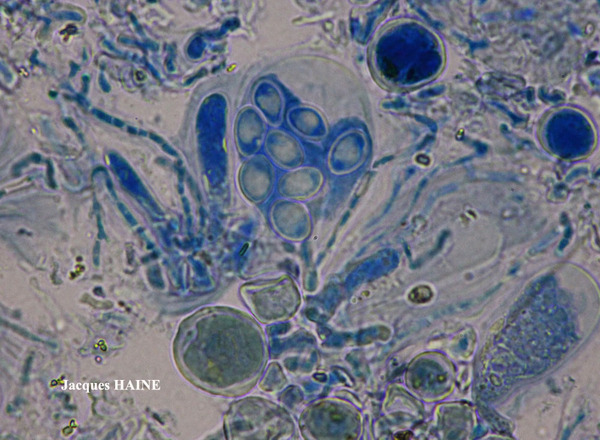
Jacques Haine - Source: http://www.lichensmaritimes.org/index.php?task=fiche&lichen=539&lang=en
Ardennes
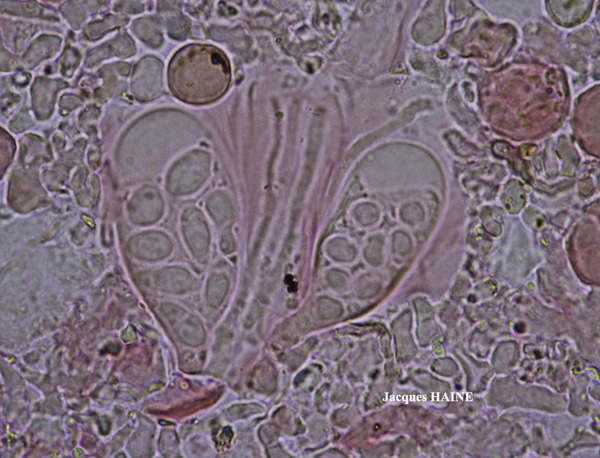
Jacques Haine - Source: http://www.lichensmaritimes.org/index.php?task=fiche&lichen=539&lang=en
Ardennes
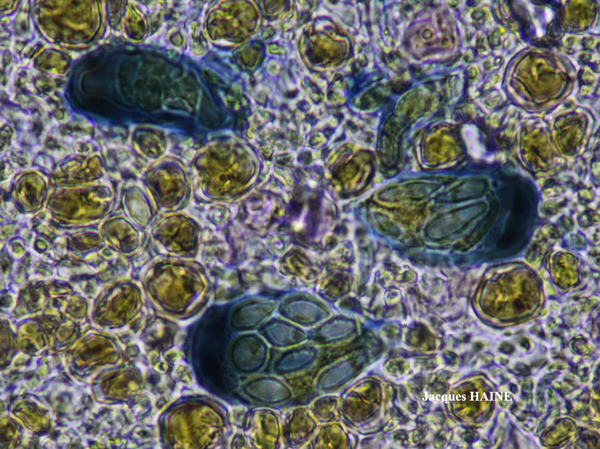
Jacques Haine - Source: http://www.lichensmaritimes.org/index.php?task=fiche&lichen=539&lang=en
Ardennes
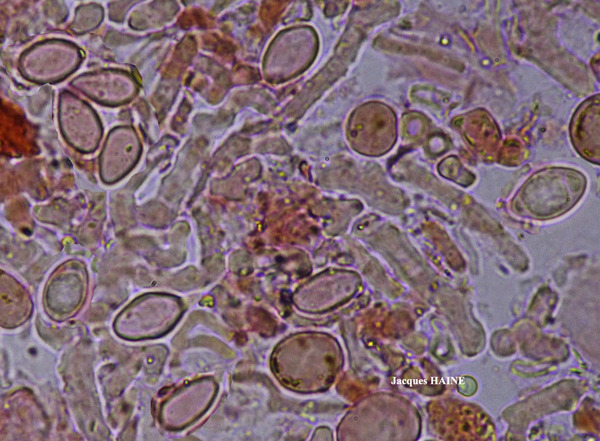
Jacques Haine - Source: http://www.lichensmaritimes.org/index.php?task=fiche&lichen=539&lang=en
Ardennes
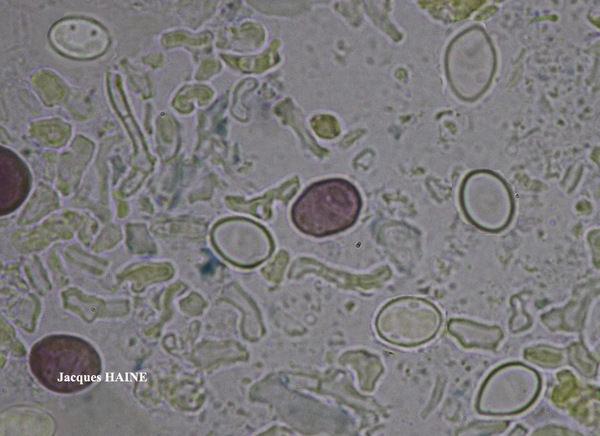
Jacques Haine - Source: http://www.lichensmaritimes.org/index.php?task=fiche&lichen=539&lang=en
Ardennes
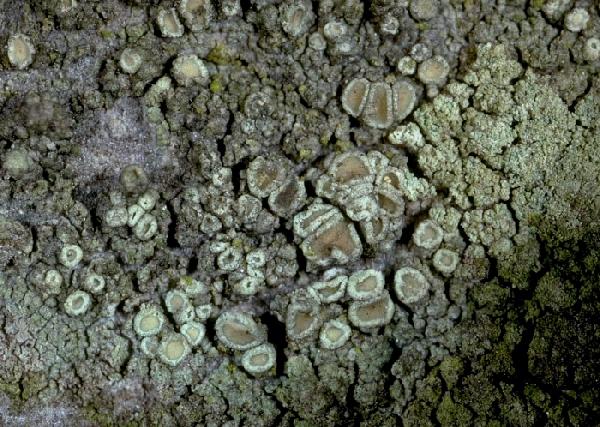
Ulrich Kirschbaum CC BY-SA 4.0 - Source: https://www.thm.de/lse/ulrich-kirschbaum/flechtenbilder
Central Europe
Growth form: Crustose
Substrata: bark
Photobiont: green algae other than Trentepohlia
Reproductive strategy: mainly sexual
Most common in areas with a humid-warm climate (e.g. most of Tyrrenian Italy)
Commonnes-rarity: (info)
Alpine belt: absent
Subalpine belt: absent
Oromediterranean belt: absent
Montane belt: absent
Submediterranean belt: very rare
Padanian area: very rare
Humid submediterranean belt: very rare
Humid mediterranean belt: absent
Dry mediterranean belt: absent

Predictive model
| Herbarium samples |

Bernard Bouffinier - Source: http://www.lichensmaritimes.org/index.php?task=fiche&lichen=539&lang=en
France, Crozon

Bernard Bouffinier - Source: http://www.lichensmaritimes.org/index.php?task=fiche&lichen=539&lang=en
France, Crozon

Bernard Bouffinier - Source: http://www.lichensmaritimes.org/index.php?task=fiche&lichen=539&lang=en
France, Menez-Meur

Bernard Bouffinier - Source: http://www.lichensmaritimes.org/index.php?task=fiche&lichen=539&lang=en
France, Menez-Meur

Bernard Bouffinier - Source: http://www.lichensmaritimes.org/index.php?task=fiche&lichen=539&lang=en
France, Menez-Meur

Bernard Bouffinier - Source: http://www.lichensmaritimes.org/index.php?task=fiche&lichen=539&lang=en
France, Menez-Meur

Bernard Bouffinier - Source: http://www.lichensmaritimes.org/index.php?task=fiche&lichen=539&lang=en
France, Menez-Meur

Jacques Haine - Source: http://www.lichensmaritimes.org/index.php?task=fiche&lichen=539&lang=en
Belgium, Han-sur-Lesse

Jacques Haine - Source: http://www.lichensmaritimes.org/index.php?task=fiche&lichen=539&lang=en
Belgium, Han-sur-Lesse
Thallus P+ red

Jacques Haine - Source: http://www.lichensmaritimes.org/index.php?task=fiche&lichen=539&lang=en
Belgium, Han-sur-Lesse
Thallus P+ red

Jacques Haine - Source: http://www.lichensmaritimes.org/index.php?task=fiche&lichen=539&lang=en
Ardennes

Jacques Haine - Source: http://www.lichensmaritimes.org/index.php?task=fiche&lichen=539&lang=en
Ardennes

Jacques Haine - Source: http://www.lichensmaritimes.org/index.php?task=fiche&lichen=539&lang=en
Ardennes

Jacques Haine - Source: http://www.lichensmaritimes.org/index.php?task=fiche&lichen=539&lang=en
Ardennes

Jacques Haine - Source: http://www.lichensmaritimes.org/index.php?task=fiche&lichen=539&lang=en
Ardennes

 DOLICHENS
DOLICHENS
